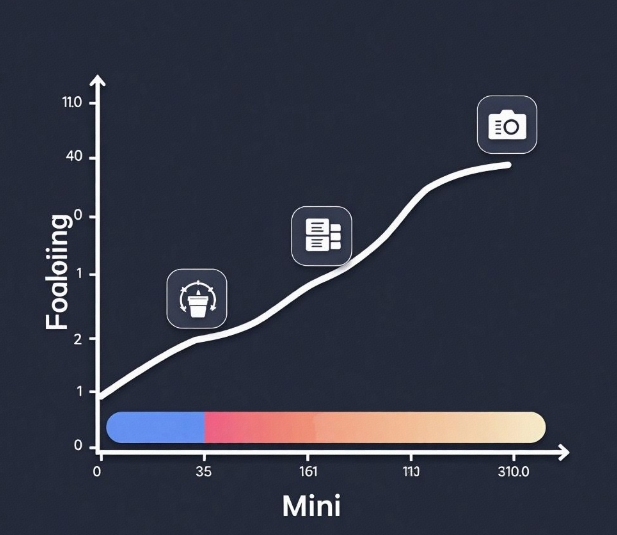User Experience Design and Optimization Techniques in Mini-Program Development
- latest articles
- 1.DApp Development & Customization: Merging Diverse Market Needs with User Experience 2.Analysis of the Core Technical System in DApp Project Development 3.How to achieve cross-chain interoperability in Web3 projects? 4.How does the tokenization of points reconstruct the e-commerce ecosystem? 5.How to Set and Track Data Metrics for a Points Mall? 6.What is DApp Development? Core Concepts and Technical Analysis 7.Inventory of commonly used Web3 development tools and usage tips 8.Development of a Distribution System Integrated with Social E-commerce 9.Six Key Steps for Businesses to Build a Points Mall System 10.What is DApp Development? A Comprehensive Guide from Concept to Implementation
- Popular Articles
- 1.Future Trends and Technology Predictions for APP Development in 2025 2.Analysis of the DeFi Ecosystem: How Developers Can Participate in Decentralized Finance Innovation 3.From Zero to One: How PI Mall Revolutionizes the Traditional E-commerce Model 4.DAPP Development | Best Practices for Professional Customization and Rapid Launch 5.Recommended by the Web3 developer community: the most noteworthy forums and resources 6.How to Develop a Successful Douyin Mini Program: Technical Architecture and Best Practices 7.From Cloud Computing to Computing Power Leasing: Building a Flexible and Scalable Computing Resource Platform 8.Shared Bike System APP: The Convenient Choice in the Era of Smart Travel 9.How to Create a Successful Dating App: From Needs Analysis to User Experience Design 10.From Design to Development: The Complete Process of Bringing an APP Idea to Life
In today's mobile internet era, mini-programs have become the preferred choice for many businesses and developers to create lightweight applications. Due to features like instant access and no installation required, mini-programs play a significant role in users' daily lives. To ensure the success of a mini-program, high-quality user experience (UX) design is undoubtedly one of the core factors. This article will explore user experience design and optimization techniques in mini-program development, helping developers enhance usability, smoothness, and user satisfaction.
I. The Importance of User Experience Design
User experience refers to the overall feeling users have while using a product, based on the product itself, its interaction design, interface design, and other aspects. For mini-programs, user experience is not just about visual design but also includes interaction flow, functionality implementation, loading speed, and more.
As users' demands for mobile internet products gradually increase, their expectations for mini-programs are also rising. If a mini-program has poor user experience, no matter how powerful its features are, users will abandon it and turn to competitors' products. Therefore, achieving excellent user experience design in mini-program development has become a key focus for developers.
II. User Experience Design Techniques in Mini-Program Development
Simple and Clear Interface Design
When using a mini-program, users are generally unwilling to spend too much time adapting to complex interfaces and cumbersome operations. Therefore, the interface design of a mini-program should follow the principles of "simplicity and intuitiveness." The layout of each page should be clear, with operation buttons and functional modules highlighting key points, and avoid adding too many irrelevant elements to prevent information overload.
For example, in homepage design, a card-based approach can present different functional modules to users in a clear and straightforward manner. At the same time, using a bright and unified color scheme helps users quickly identify various functions.
Reasonable Interaction Design
The interaction design of a mini-program should align with users' habits, enabling them to complete tasks smoothly. Whether it's the size and placement of buttons or the animation effects for page transitions, everything needs to be carefully designed. Buttons and controls should be sufficiently clickable, avoiding being too small or too densely packed, which could affect the accuracy of user clicks.
Additionally, transitions between pages should be natural and smooth, avoiding long loading times. Using gradient animations or transition effects can make page switches smoother, enhancing the overall experience.
Fast Response Speed
One of the core advantages of mini-programs is their fast response speed, and users do not want to encounter long waiting times during use. To achieve this, developers should optimize the loading speed of mini-programs, reduce unnecessary requests and data transfers, and ensure short loading times across different network environments.
Furthermore, reasonable caching mechanisms and data preloading can improve the loading speed of mini-programs. For example, when a user enters a mini-program, commonly used resources can be preloaded to ensure no lag during use.
Clear Operation Guidance
For first-time users of a mini-program, operation guidance is crucial. Designing a clear and concise guidance process can help users quickly understand the main functions and usage methods of the mini-program, reducing drop-off due to unfamiliarity with operations.
Guidance can be provided through pop-up prompts, guide icons, swipe tutorials, etc. The guidance process should be brief and straightforward, avoiding confusion or annoyance for users.
Attention to Detail Design
In user experience design, details often determine success or failure. For example, button feedback effects, text alignment, and icon design all impact the user's overall impression. The detail design of a mini-program needs to be refined, ensuring every aspect considers the user's experience.
For instance, when a user clicks a button, there should be slight scaling or color change feedback to indicate the system has received the action. Additionally, text on the page should be clearly visible, avoiding overly small fonts or unsuitable color combinations.
III. Optimization Techniques for Mini-Programs
During the development of mini-programs, optimization is also crucial. Through optimization, the efficiency and user experience of mini-programs can be effectively enhanced. Below are some common optimization techniques for mini-programs.
Image Optimization
Images in mini-programs often account for a significant portion of loading time and data usage. Therefore, image optimization is key to improving loading speed. Developers should ensure that image sizes and formats are suitable for mobile use, avoiding overly large image files that slow down loading.
Additionally, using lazy loading techniques for images can further reduce resource consumption during loading, ensuring users do not experience lag while browsing.
Code Optimization
During development, code optimization is also key to improving mini-program performance. Developers can compress and merge code files, reduce unnecessary external requests, and minimize the startup time and runtime resource usage of mini-programs. At the same time, avoid overly complex code logic to ensure smooth operation across various devices.
Reducing Unnecessary Requests
Every time a user opens a mini-program, requests are sent to the server to fetch data. Frequent requests not only affect the loading speed of the mini-program but may also lead to user drop-off. Developers should reduce unnecessary requests and use local caching to store commonly used data, minimizing reliance on network requests.
Compatibility Optimization
Due to performance differences in handling mini-programs across different phone models and operating system versions, developers should conduct compatibility testing to ensure the mini-program runs smoothly on mainstream devices. The simulator in the WeChat Developer Tools can be used to test compatibility, and optimizations can be made based on the test results.
User Behavior Analysis and Feedback
Collecting user behavior data within the mini-program through analytics tools helps understand user needs and preferences. Based on this data, developers can optimize the functional layout and interaction methods of the mini-program, improving overall user satisfaction.
IV. Conclusion
In the development of mini-programs, user experience design and optimization techniques are critical factors influencing their success. An excellent mini-program not only requires rich features and content but also needs optimization in interface design, interaction experience, loading speed, and other aspects. Through simple and clear interfaces, smooth interaction design, fast response speeds, and meticulous optimization strategies, the user experience of mini-programs can be significantly enhanced, thereby increasing user retention and satisfaction.
As the mobile internet continues to evolve, user expectations for mini-programs will also rise. Developers need to constantly monitor changes in user demands and continuously improve and optimize mini-programs to stand out in the competitive market.
-

How to Increase User Stickiness and Activity Through Mini Program Development
With the development of the internet and mobile internet, mini-programs, as an e···
-

How can mini-program development assist in corporate marketing and e-commerce transformation?
In today's rapidly evolving mobile internet landscape, corporate marketing and e···
-

Offline Functionality Design and Data Synchronization in Mini-Program Development
With the rapid development of mobile internet, mini-programs, as a lightweight a···

 Blockchain
Blockchain












